Last weekend, I joined Eric, Erin, Maya, Colin, and Kaya in hiking 雪山 (Xueshan), or Snow Mountain, Taiwan’s second-tallest peak.1 Tackling this hike was a physical and mental challenge, and I’m proud to have completed it.
Doing a hike like this in Taiwan takes multiple months of advance planning to organize cabin slots, gear rentals, and mountain permits. As the date crept closer, I began to dread our plans getting foiled by weather. Taiwan’s weather, especially in the mountains and especially this time of year, is super unpredictable and very rainy. Our group took off for the trailhead on Friday afternoon, paying no mind to an iffy forecast for Saturday. Our 2.5-hour drive was extended by a road closure deep in the mountains. Excavators, perched high up on a cliff, chucked boulders downhill, rockfall and debris crashing loudly onto the road below. Every 2 hours, a bulldozer would clear the road, and cars would be allowed to pass for 15 minutes. Staring up at the massive rock face while massive potholes (from chucked boulders) jolted us around was a harrowing experience. We arrived at the trailhead around 6pm and hiked 2 kilometers up to Qika Hut, where we spent our first night. Using my hiking pants as a pillow and sharing a room with upwards of 30 other hikers, the chorus of snores, farts, and sleeptalking only allowed me about half an hour of sleep, max. We got up at 2am, grabbed some breakfast, and began up the mountain.
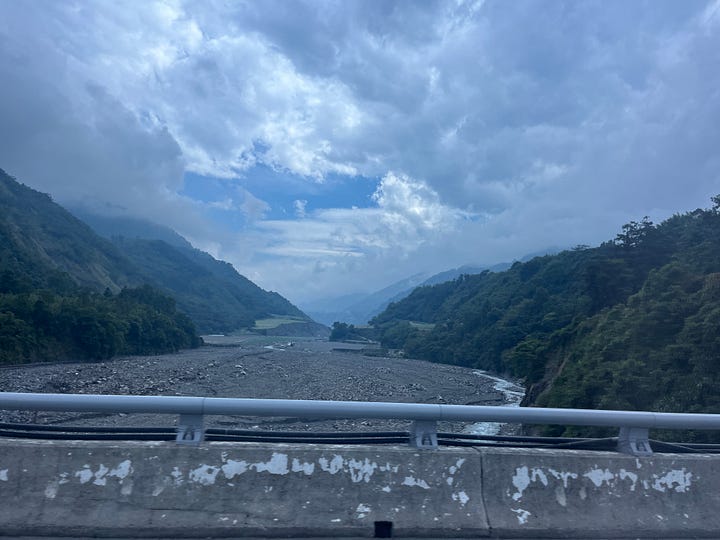

The early morning weather was perfect. We caught a phenomenal view of the sunrise from the East Peak, watching the surrounding mountains turn from black outlines to rugged green and full of depth, wispy clouds forming in bottomless valleys. We kept pushing towards the peak, eventually arriving at the base of the Xueshan Cirques some 3.5 hours later. Other hikers had told us that bad weather was rolling in around noon, so we had been hustling to get to the summit. Moving fast was really difficult at this elevation, especially considering we hadn’t taken much time to let our bodies adjust. I took an ibuprofen to stave off altitude sickness symptoms but was still struggling to catch my breath. The stretch leading up to the summit felt like the hardest hiking of the day. Thick clouds were setting in by this point, and our group spread out along the trail as we battled up the scree field, everyone fighting their own battle to the summit.2 The fog was so thick I lost sight of everyone ahead/behind me on the trail, all I could see was waves of mist ripping through a field of rhododendrons just in front of me. It felt apocalyptic. I finally made it to the top, and hardly had time to catch my breath before another hiking group recommended we descend— the storm was coming soon.
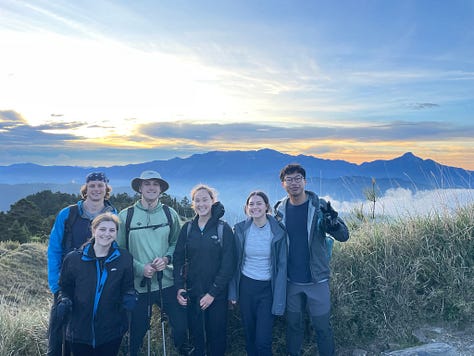
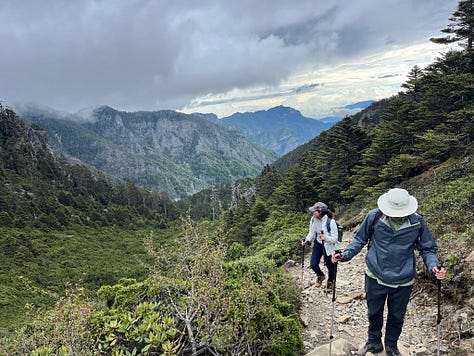



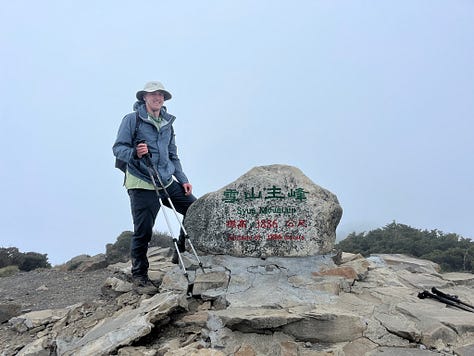
Clouds thickened as we started down the mountain, and the rain began shortly after we dipped below the treeline. Thunder rolled from somewhere behind us, and the rain began to grow in intensity. Still 4+ hours from the trailhead, we picked up the pace and braced ourselves for a long afternoon. I don’t think any of us were quite prepared for how awful this descent would be— the rain came so quick and so heavily that the flat stretches of our trail became pools and the steep parts became streams. We trod carefully with our hiking poles, straining to guide our shaking legs through the set of miniature waterfalls that made up our trail. It felt like we encountered uphill sections (formerly downhill sections on our ascent) that hadn’t existed before, and I recall the sheer length of the trail ahead of me feeling crushing as the first hints of moisture entered my hiking boots. I eventually entered a sort of zen state, focusing solely on the hot shower at the end of the figurative tunnel, moving as quickly and efficiently down the mountain as possible, largely speechless aside from a rare comment to Colin about being drenched. We reached the parking lot around 3pm, everyone antsy to get-the-hell-home as quickly as we could. Major shoutout to Colin for driving us the 2.5 hours home after this whole ordeal.3
As awful as the descent was, the experience as a whole was undoubtedly a highlight of my time here in Taiwan. This place is truly a hiker’s paradise, and I know that this won’t be my last time exploring the mountains here. Time/distance/elevations for the hike can be found at the end of this post.
Sore and tired, I woke up Sunday morning to head to New Taipei’s Yingge District with my host family. This district has been the epicenter of Taiwan’s ceramics industry for over 100 years and is the place to go if you want cheap, high-quality pottery. I was in the market for a tea set to bring back home and figured this district would have the best selection and prices anywhere in Taiwan. Yingge’s Old Street has an overwhelming amount of ceramics stores, which are each individually overwhelming to enter. I spent the early afternoon shopping, my host dad browsing with me and providing a helpful second set of eyes. Machine-made teapots ranged from $5-20 USD, while the handmade pieces were mostly $40 US and up. The first few stores I entered were really fancy, with a limited selection of teapots and cups designed for specific types of tea, most well over $100. There were some cool teapots, but I’m glad I kept exploring, as I found a small, hole-in-the-wall shop with tons of options. I found a simple handmade teapot and 6 bone white cups to go along with it. All in around $70 USD.4
After this successful purchase, my host dad and I picked up some peanut ice cream rolls, a Taiwanese specialty that originated in Yilan County. Two scoops of ice cream (taro and pineapple flavor) are topped with peanut brittle and cilantro and wrapped in a thin crepe. The cilantro sounds like an odd addition, but this is truly one of those things you can’t knock until you try. Refreshing, complex, and cheap. Truly doesn’t get much better.
On the way back to Luodong in the afternoon, my host family graciously stopped in Taipei so I could return all of our rented hiking gear. I’m thankful that they wanted to go on this adventure with me, and without my host dad’s gentle questioning (are you sure you don’t want to check out a few more places?), I probably would have ended up with an obnoxious fancy teapot and severe buyer’s remorse.
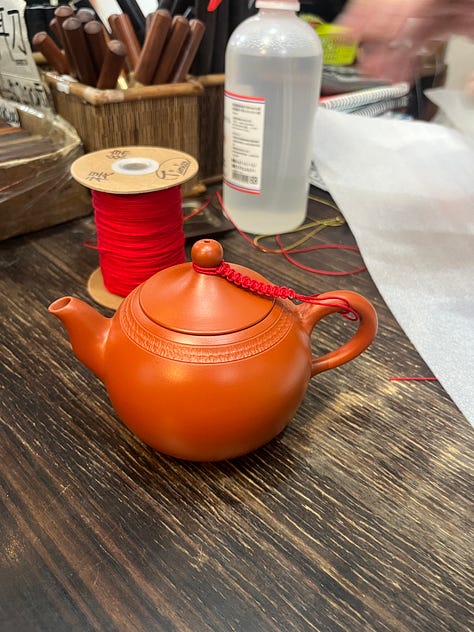
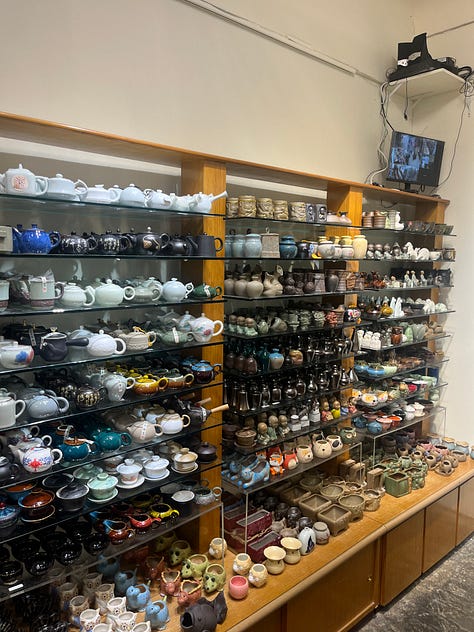

On Monday, I joined my branch campus on a field trip to Tofu Cape. Students and teachers grouped up and set out in kayaks, splashing each other and paddling around the cove until everyone was exhausted. This field trip was meant to encourage students not to be scared of the water, as the percentage of Taiwanese who can swim is significantly lower than most other high-income countries. Kayaking in Tofu Cape was the first of three field trips scheduled over the next two weeks; the floodgates of fun seemingly opened now that most classes have moved on to reviewing material before final exams.


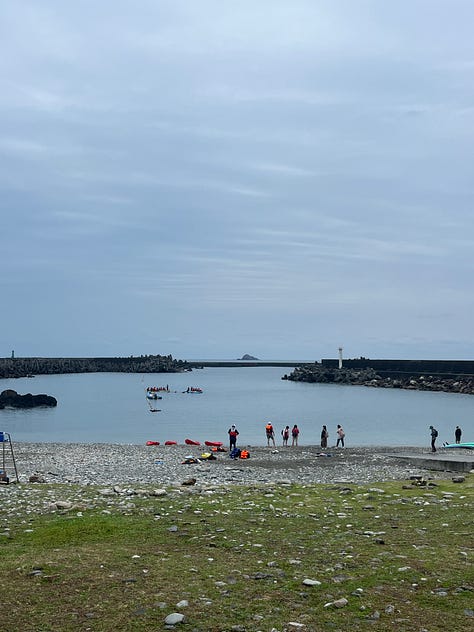
On Wednesday after class, I joined my 6th graders for music practice. Shun-An has a school potluck in mid-June, and I’ve been asked to accompany my 6th graders on guitar. They are singing a Taiwanese tune from the late 80s called 快樂天堂, or Happy Paradise. The music video is classic 80s Taiwan and is worth a watch. I’m looking forward to the performance, although I have a long way to go before I’m comfortable playing this song in front of a large audience.
I stopped at a Vietnamese restaurant near my house for lunch. This place is located right in the middle of Luodong’s traditional market, where fruits, vegetables, and spices are hawked from the roadside almost every morning.5 I ordered some cold noodles with pork (obviously delicious, cold noodles never miss) and banh xeo, a dish I hadn’t tried before.6 This banh xeo was crispy pancake stuffed with pork, onions, bean sprouts, and shrimp, and came with tons of fresh veggies. I shamelessly Googled “how to eat banh xeo” before digging in with my hands, wrapping hunks of the pancake in lettuce, topping with Thai basil, mint, and cucumber before dunking it all into a sweet fish sauce. It was delicious but messy, and I left lunch absolutely stuffed. As I’ve likely mentioned before, Vietnamese restaurants are some of the only restaurants I can go to find vegetables devoid of oil and garlic, and they always really load up my plate.


On Thursday, my branch campus had another field trip in Daxi Village, home to Taiwan’s third-largest fishing port. Our first stop was Daxi Elementary School, where we had a boogie boarding lesson.7 The weather was awful; wind and rain were swirling everywhere, but the ocean was warm and calm, so we paid no mind to the weather and got straight to business. Most of my students hadn’t boogie boarded before, and seeing them light up when catching a wave was super cool. I don’t find boogie boarding particularly exciting on its own, but doing it alongside my students was pure belly-laughing exhilaration. A few teachers and our principal all got in on the action, and our hour in the water passed before we knew it.
We rinsed off and headed to an acitivity center where students learned about ocean life, littering, and identified fish specimens. One of my coworkers said it best when she said “Taiwan has seafood culture, but not ocean culture.” This is to say that plenty of people here eat seafood but don’t understand the fragility of ocean ecosystems, the impact of pollution, or the fun that you can have in the ocean. Paired with the field trip on Monday to Tofu Cape, I think my school is doing an awesome job in setting these students up to be more thoughtful about the ocean, both as a food source and as an ecosystem to be protected.
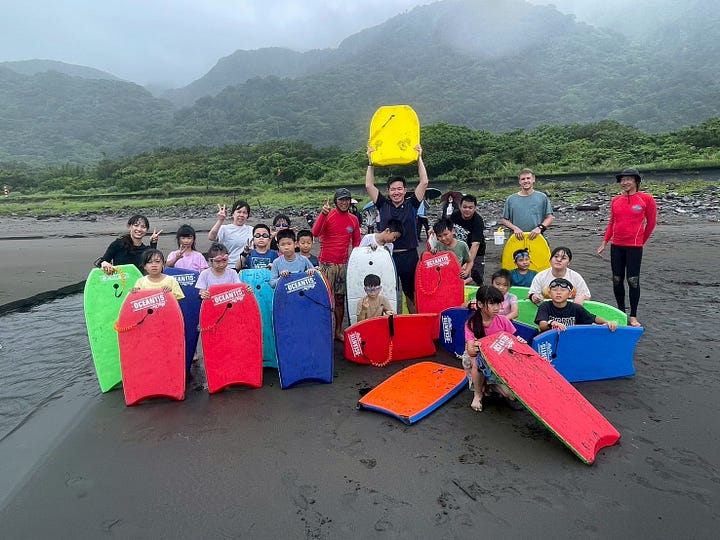
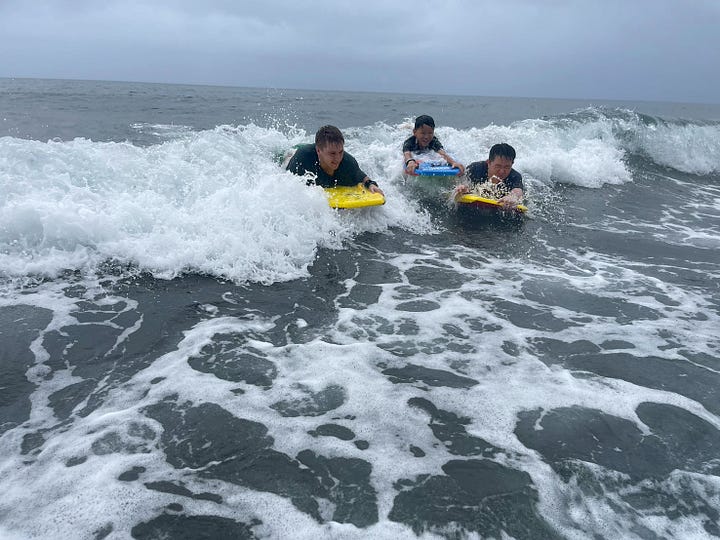
Soundtracks to my week have included…
Let the Music Take Your Mind by the Greyboy Allstars
Dick’s Picks Vol. 25 by the Grateful Dead
Get Back by Eric Krasno
Thanks for reading! Email me at bwcopel@gmail.com with any thoughts and concerns you might have.


XUESHAN TIME MARKERS:
Trailhead (0km, 2140m): Arrived Friday 6:00pm
Qika (2km, 2460m): Arrived Friday 6:50pm, departed Saturday 2:45am
Xueshan East Peak (5.1km, 3201m): Arrived 5:00am
369 Cabin (7km, 3150m): Arrived 6:00am
Base of Xueshan Cirques (9.8km, 3630m): Arrived 8:30am
Summit (10.9km, 3886m): Arrived 9:30am
Trailhead (21.8km, 2140m): Arrived 3:00pm
And thus the second-tallest peak in all of East Asia.
At least I was.
I’d also like to thank James Dixon for planting the idea of a big Taiwan hike in my brain. He did Fulbright last year and hiked Yushan, Taiwan’s tallest peak.
Personally think this basic clay teapot is simply gorgeous. I was advised never to wash it, to allow a patina to develop on the outside and “seasoning” on the inside. It’s suggested only use this pot with one type of tea, and I think this will be my oolong pot once I get home.
Indicating that this place uses super fresh produce. It certainly tasted like it.
Pronounced “ban say-oh” I think. Thankfully, I ordered in Chinese, and didn’t have to try and pronounce this.
Shoutout to Anna, a fellow Yilan ETA who works at this school! I got to see her briefly while we were waiting for lunch. This might be the most beautiful school in the whole country.


You are so brave for getting out of bed on Sunday